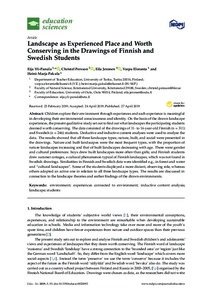Landscape as Experienced Place and Worth Conserving in the Drawings of Finnish and Swedish Students
Eila Jeronen; Heini-Marja Pakula; Varpu Eloranta; Eija Yli-Panula; Christel Persson
https://urn.fi/URN:NBN:fi-fe2021042824082
Tiivistelmä
Children explore their environment through experiences and each experience is meaningful in developing their environmental consciousness and identity. On the basis of the drawn landscape experiences, the present qualitative study set out to find out what landscapes the participating students deemed worth conserving. The data consisted of the drawings of 11- to 16-year-old Finnish (n = 311) and Swedish (n = 246) students. Deductive and inductive content analyses were used to analyse the data. The results showed that all three landscape types; nature, built, and social were presented in the drawings. Nature and built landscapes were the most frequent types, with the proportion of nature landscapes increasing and that of built landscapes decreasing with age. There were gender and cultural preferences: boys drew built landscapes more often than girls; and Finnish students drew summer cottages, a cultural phenomenon typical of Finnish landscapes, which was not found in Swedish drawings. Similarities in Finnish and Swedish data were identified e.g., in forest and water and “cultural landscapes”. Some of the students displayed a more distant, observing role, whereas others adopted an active one in relation to all three landscape types. The results are discussed in connection to the landscape theories and earlier findings of the drawn environments.
Kokoelmat
- Rinnakkaistallenteet [19250]
